Students can Download 1st PUC Biology Previous Year Question Paper March 2018 (South), Karnataka 1st PUC Biology Model Question Papers with Answers helps you to revise the complete Karnataka State Board Syllabus and score more marks in your examinations.
Karnataka 1st PUC Biology Previous Year Question Paper March 2018 (South)
Time: 3.15 Hours
Max Marks: 70
General Instructions:
- The question paper consists of four parts A, B, C, and D.
- All the parts are compulsory.
- Draw diagrams wherever necessary. Unlabelled diagrams or illustrations do not attract any marks.
Part – A
Answer the following questions in one word / one sentence each: ( 10 × 1 = 10 )
Question 1.
What is a taxon?
Answer:
A taxon is a unit of classification.
Question 2.
Name the type of root modification in banyan.
Answer:
Prop roots.
Question 3.
Name the family in which the flowers show papilionaceous corolla.
Answer:
Family Fabaceae.
Question 4.
What is a closed vascular, bundle?
Answer:
Avascular cambium in which cambium is absent is known as a closed vascular bundle.
Question 5.
Name the type of plastids that store carbohydrates.
Answer:
Amyloplasts.
![]()
Question 6.
During which stage does synapsis occur?
Answer:
Zygotene.
Question 7.
What are porins?
Answer:
Porins are proteins that form huge pores in the outer membranes of plastids, mitochondria and some bacteria allowing molecules up to the size of small proteins to pass through.
Question 8.
Name the enzyme which helps in nitrogen reduction in prokaryotes.
Answer:
Nitrogenase.
Question 9.
Which type of cells of gastric glands secrete HCl.
Answer:
Parietal cells or oxyntic cells of gastric glands secrete HCl.
Question 10.
What is serum?
Answer:
Plasma without cloning factors is known as serum.
PART-B
Answer any FIVE of the following questions in 3-5 sentences each, wherever applicable. (5 × 2 = 10)
Question 11.
Mention any two major groups of protozoans with an example for each.
Answer:
- Amoeboid protozoans e.g. Amoeba, Entamoeba,
- Flagellated protozoans eg: Trypanosoma
- Ciliated protozoans eg. Paramecium
- sporozoans eg: plasmodium (Any two)
![]()
Question 12.
Distinguish between diploblastic and triploblastic animals. Give an example for each.
Answer:
Animals in which the cells are arranged in two embryonic layers namely ectoderm and endoderm are known as diploblastic animals, e.g. coelenterates.
Question 13.
What is phyllotaxy? Name any two types.
Answer:
Patterns of arrangement of leaves on the stem or branch are known as phyllotaxy.
Types of phyllotaxy include – alternate, opposite and whorled.
Question 14.
What are nephridia? Mention their types.
Answer:
Nephridia are excretory organs in earthworms. Types are septal, integumentary and pharyngeal
Question 15.
Draw a neat labelled diagram of a mitochondrion.
Answer:
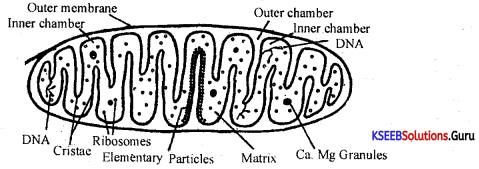
Section through mitochondrion (diagrammatic)
The elementary particles have been shown only on one crista.
Question 16.
Write the physiological effects of cytokinins in plants.
Answer:
Physiological effects of cytokinins:
- helps to produce new leaves, chloroplast in leaves, lateral shoot growth and adventitious shoot formation.
- helps to overcome apical dominance.
- promotes nutrient mobilization which helps in the delay of leaf senescence.
- promotes shoot initiation.
Question 17.
What are joints? Name any two types of joints in man.
Answer:
Joints are points of contact between bones or between bones and cartilages.
Types:
- Filariousjoints
- Cartilaginous joints
- Synovial joints (any two)
![]()
Question 18.
What is (a) tetany (b) arthritis?
Answer:
(a) Rapid spasms in muscles due to low Ca+2 in body fluids.
(b) Arthritis: inflammation of joints.
PART-C
Answer any FIVE of the following questions in 40-80 words each, wherever applicable: (5 × 3 = 15)
Question 19.
Briefly explain any three types of taxonomical aids.
Answer:
All those collections of actual live specimens or preserved specimens, which help in the identification or verification of a species, are called taxonomic aids.
Some of them include,
- Herbarium
- Botanical Gardens
- Museums
- Zoological Parks
- Keys
- Monographs
- Manuals
- Floras.
1. Herbarium:
A herbarium is defined as a collection of plants, that have been dried, pressed and preserved on sheets.
These sheets are arranged in accordance with any accepted system of classification. They can be used for future references.
2. Botanical Gardens:
These are collections of living plants maintained for reference, i.e., they are meant for identification and classification. Both local and exotic plants are grown.
- These are considered natural and economical reference systems.
- Following are some famous botanical gardens in India.
1. Indian Botanical Garden, Howrah.
2. National Botanical Research Institute, Lucknow.
3. Museums:
- Museums are those places that have collections of preserved animals and plants for taxonomic studies.
- The plant and animal specimens are kept in chemical solutions of formalin and are preserved for a longer duration.
- Plant and animal specimens may also be preserved as dry specimens.
- Insects are preserved in insect boxes. The collected insects are dried and pinned in these boxes.
- Larger açimals like birds and mammals are usually preserved as stuffed specimens.
- Skeletons of animals are also collected in the museums.
- The specimens have been correctly identified, labelled and stored.
- A catalogue of specimens is prepared for future use.
4. Zoological Parks:
- These are the places where wild animals are protected in conditions very similar to their natural habitats. Food and shelter are provided. The health of the animal is monitored and a chance for reproduction (mating) is given.
- The scientific purpose of such parks is to breed animals under captivity to avoid extinction.
![]()
Question 20.
Draw a neat labelled diagram of phloem.
Answer:
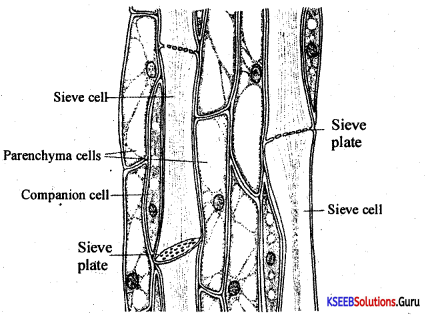
Question 21.
Mention the significance of mitosis.
Answer:
- The somatic chromosome number (2n) in all the cells of an organism is effectively maintained by mitosis. The duplication of chromosomes occurs during interphase and their orderly behaviour during the different stages of mitosis maintains a constant chromosome number.
- 11 daughter cells produced as a result of mitosis are quantitatively and qualitatively identical.
- Mitosis of somatic cells helps in the growth and development of multicellular organisms.
- It forms a means of multiplication in some of the lower organisms eg: Amoeba, Euglena etc.
- Mitosis produces new cells for the healing of wounds and for regeneration.
Question 22.
What is photoperiodism? Classify the plants based on photoperiodism.
Answer:
Plants, in order to flower, requìre a particular day length or light period called photoperiod and the response of the plants to photoperiod in terms of flowering is called photoperiodism. Photoperiodism was first studied by W.W. Garner, and HA. Allard.
Based on their photoperiodic responses, plants are classified into the following groups:
- Long Day Plants: These flower in photoperiod more than critical day length. e.g: Wheat, oats etc.
- Short Day Plants: These flower in photoperiod less than critical day length. e.g: Tobacco, Chrysanthemums etc.
- Day Neutral Plants: These are the plants that are not influenced by the dùration of light for their flowering.
e.g: Tomato, cucumber, Cotton etc.
Question 23.
Briefly explain the role of enzymes in the digestion of disaccharides.
Answer:
(a) Lactose – helps in the breakdown of lactose into a molecule of glucose and a molecule of galactose.
(b) Sucrase – helps in the breakdown of sucrose into a molecule of glucose and a molecule of fructose.
(c) Maltase – helps in the breakdown of maltose into 2 molecules of glucose.
or
Sucrase:
It converts sucrose into glucose and fructose.
![]()
Maltase :
It converts maltose into glucose and glucose.
![]()
Lactase:
It converts Lactose into Glucose and Galactose.
![]()
Question 24.
Briefly describe the transport of CO2 in the blood.
Answer:
CO2 is produced within the body cell as a metabolic waste product of oxidative metabolism.
CO2 is transported from cells to the alveoli through the following forms.
1. In the form of carbonic acid (7%).
2. In the form of carbamino haemoglobin (23%).
3. In the form of bicarbonates of Sodium and Potassium (70%).
Question 25.
Write a note on any three disorders of the circulatory system.
Answer:
(a) High blood pressure (Hypertension): B.P that is higher than the normal value of 120/80 mm Hg is known as hypertension.
(b) Coronary Artery Disease (CAD): Lumen of blood vessels become narrow due to deposition of calcium, fat, cholesterol etc. affecting the blood supply to the heart.
(c) Angina: symptoms of acute pain when enough O2 is not reaching the heart muscle.
![]()
Question 26.
Briefly explain the role of lungs, liver and skin as excretory organs.
Answer:
Role of lungs: Lungs removes large amounts of CO2 and also water.
Liver: removes bilirubin, biliverdin, cholesterol, degraded steroids, hormones, vitamins and
Skin-sweat glands help in the removal of sweat containing NaCl, small amounts of urea, lactic acid etc. Sebaceous glands help in the removal of sterols, hydrocarbons and waxes through
Part-D ( Section -I ).
I. Answer any FOUR of the following questions in 200-250 words each. ( 4 × 5 = 20 )
Question 27.
List any four important characters of gymnosperms. Give two examples.
Answer:
1. The life cycle has a distinct, dominant, diploid, asexual phase represented by the well-differentiated evergreen woody plant, which is known as the sporophyte.
2. The sporophyte is heterosporous bearing microspores and megaspores within microsporangia and megasporangia respectively. These structures occur on leaf-like microsporophylls and megasporophylls. These are further organised into fertile structures called strobili or cones.
3. Sporophyte shows the presence of a taproot system which is welt developed. The stem possesses branches that are dichotomies. Leaves are welt developed and are dimorphic (two types of leaves): viz,
- Green photosynthetic leaves (Foliage).
- Brown coloured scale leaves.
4. Microspore develops into male gametophyte and megaspore produces female gametophyte.
These gametophytes represent the haploid phase and are highly inconspicuous in comparison with sporophytic generation.
Question 28.
Write the general characters of class Aves.
Answer:
- Birds are homeothermic (warm-blooded) animals.
- The body is boat-shaped and is adapted in such a way as to offer the least resistance while flying
- The body is differentiated into an ahead, long neck, a trunk and a short tail.
- The body is covered by feathers, which provide insulation.
- Forelimbs are modified into wings for flight. Wings are provided with feathers, which are bad conductors of heat.
- The hind limbs are shifted forwards to balance the body while walking. They are variously modified for perching, walking, running, swimming etc.,
- Hind limbs have 4 toes and are covered, with epidermal scales.
- The endoskeleton is fully ossified (bony). Bones are tubular and hollow fond have air cavities or air sacs (pneumatic bones).
- The bones of the skull are fused.
- Jaws are devoid of teeth but covered by horny sheaths and are modified to form a beak.
- The beak is variously modified to suit individual food habits.
Question 29.
Draw a neat labelled diagram of the male reproductive system of cockroaches.
Answer:
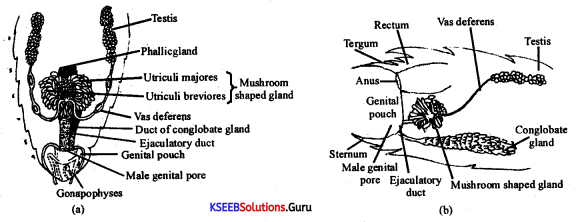
Question 30.
Describe the fluid mosaic model of the cell membrane.
Answer:
Fluid mosaic Model By Singer & Nicholson:
(a) According to this model, the plasma membrane consists of a double layer of lipid molecules and globular protein molecules and sterols distributed at random. In comparative terms, it can be said that the plasma membrane is formed of ‘protein icebergs in the sea of lipids’.
(b) The protein molecules are globular proteins and these proteins penetrate or lie at the periphery to form a mosaic pattern.
(c) Heads of the phospholipid molecules of the two layers are directed ¡n the opposite directions while tails of the two layers face each other.
(d) In animal cells glycolipids and cholesterol are also present along with proteins.
![]()
Question 31.
(a) Briefly describe the factors affecting enzyme activity. (3M)
(b) What is homopolymer? Give an example. (2M)
Answer:
(a) Factors affecting enzyme activity:
- Temperature and pH: Enzymes generally function within a narrow range of temperature and pH. Each enzyme shows the highest activity at an optimum temperature and pH. At low or high temperatures and pH, enzymes become inactive.
- The concentration of substrate: With the increase in substrate concentration, the velocity of the enzymatic activity rises at first, reaches a maximum velocity beyond which it does not increase further when the concentration of substrate is increased.
(b) Homopolymer: A polysaccharide consisting of only one type of monosaccharides. e.g. cellulose, insulin etc.
Question 32.
Transpiration and photosynthesis in plants is a compromise. Substantiate.
Answer:
(a) Transpiration creates transpiration pull for absorption and transport implants.
(b) Transpiration pull supplies water for photosynthesis.
(c) Transports minerals from the soil to all parts of the plants.
(d) Transpired water cools leaf surfaces.
(e) Entry of water due to transpiration maintains the shape and structure of the plants by keeping cells turgid.
(f) Plants need water for photosynthesis and it can be limited by the availability of water which can be swiftly depleted by transpiration. The humidity of rainforests is due to the cycling of water.
(g) The evolution of the CAM photosynthetic pathway helps in maximising the availability of C02 while minimising water loss.
Section – II
II. Answer any THREE of the following questions in 200-250 words each, wherever applicable. (5 × 3 = 15)
Question 33.
Describe the nodule formation in leguminous plants.
Answer:
- When the root hair of a leguminous plant comes in contact with Rhizobium, it becomes curled or deformed due to the chemicals secreted by the bacterium.
- The rhizobia enter these deformed root hair and proliferate within the root hair.
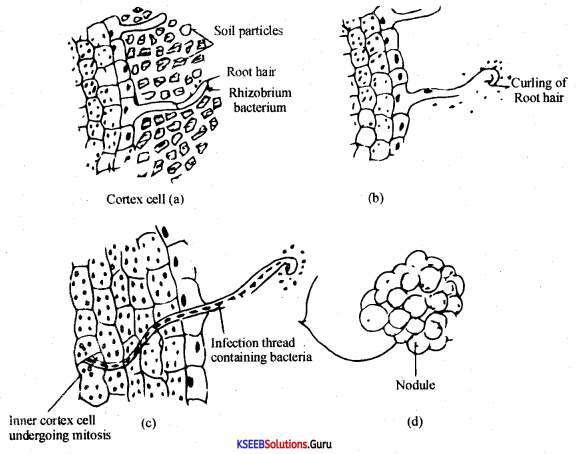
Question 34.
Write the schematic representation of the Z-scheme of light reaction.
Answer:
Non-cyclic photophosphorylation is also called ‘Z’ scheme electron transport.
In this cycle, the electrons lost by chlorophyll pigment do not return to the same molecule.
Both PS I and PS II are utilised.
One molecule of ATP is formed.
Two molecules of NADPFI2 are formed.
One molecule of O2 is formed,
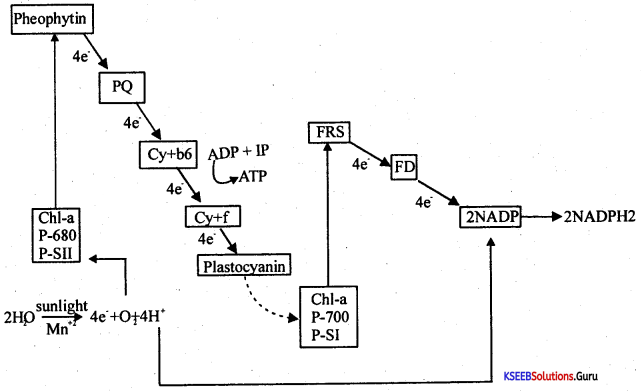
Question 35.
(a) What is respiratory quotient (RQ)
Mention the RQ values for carbohydrates, fats and proteins during aerobic respiration. (4M)
Answer:
Respiratory quotient (R-Q)
The respiratory quotient can be defined as the ratio of the volume of CO2 released, to O2 consumed to break one molecule of respiratory substrate completely.
RQ = \(\frac{\text { Volume of } \mathrm{CO}_{2} \text { released }}{\text { Volume of } \mathrm{O}_{2} \text { consumed }}\)
RQ of carbohydrate is 1.
RQ of proteins ¡s 0.7
RQ of fats ¡s 0.71
RQ of organic acid is more than 1(1.2 or 1.3).
(b) The respiratory pathway in plants is called the amphibolic pathway. Why? (1M)
Answer:
Since respiration involves the breakdown of organic compounds, it has been considered as a catabolic process and the respiratory pathway as a catabolic process. But as different substances enter the pathway as respiratory substrates, and certain intermediate of the respiratory pathway is also withdrawn for the synthesis of other compounds.
For e.g: Fatty acids would be broken down into acetyl COA for entering the pathway, acetyl C, A from the respiratory pathway will be taken out ¡f fatty acids have to be synthesised.
Similarly to the respiratory pathway, intermediates are involved in the synthesis of proteins, because the respiratory pathway involves both anabolism and catabolism it is called an amphibolic pathway.
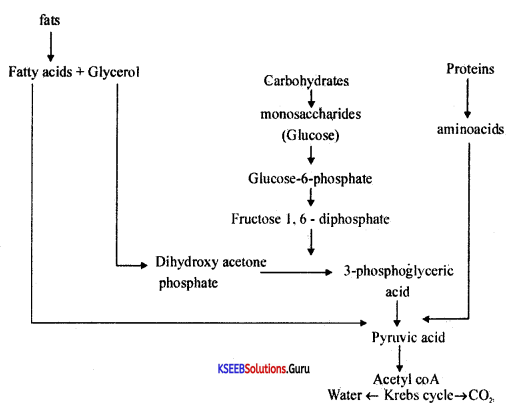
![]()
Question 36.
Draw a neat labelled diagram of the sagittal section of the human brain.
Answer:

Question 37.
Name the hormones which are responsible for the following functions.
(a) Stimulates the resorption of water and electrolytes in kidneys.
(b) Maintains sleep-wake cycle.
(c) Regulates the blood calcium level.
(d) Provides immunity
(e) Supports pregnancy.
Answer:
(a) ADH or vasopressin.
(b) Melatonin
(c) Calcitonin
(d) Thymosins
(e) Progesterone.